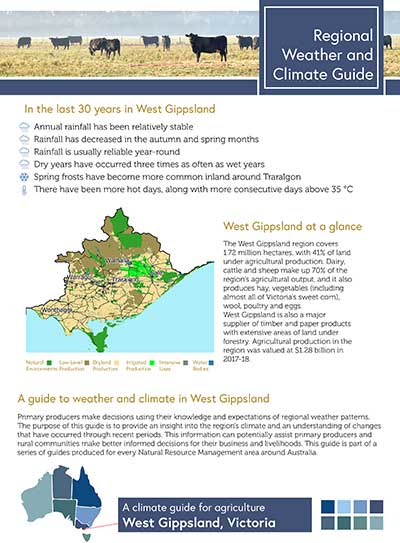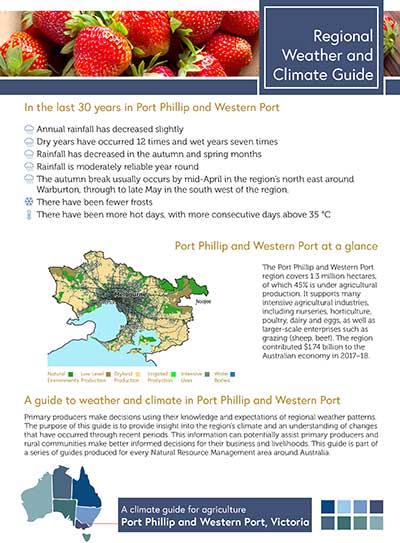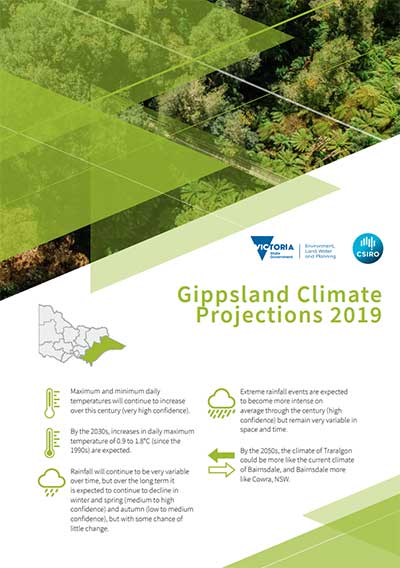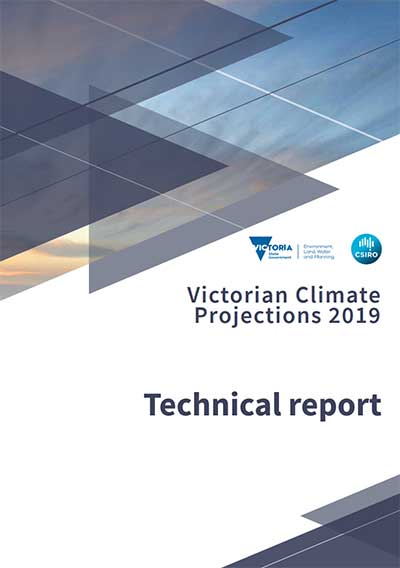Southern Gippsland - Future Climate
Our climate is changing. Over the past 100 years, global surface air temperatures have risen by almost 1°C, and over 1.5oC in Australia. On average, rainfall has declined since the 1950s, especially in Autumn. Despite an overall trend of declining rainfall, more of the rain that does fall occurs in increasingly extreme downpours. This is likely to lead to an increase in the incidence of flooding events, particularly in urbanised catchments, small catchments and low-lying areas.
2019 was the driest year on record for most of Australia. Although Southern Gippsland was one of the exceptions, receiving average rainfall due to cold fronts. Rainfall patterns and timing have modified since the 1990s, with increasing high-pressure systems pushing a lot of our rainfall offshore, causing drier conditions. This has coincided with consistently increasing maximum temperatures across Australia. The warming is particularly notable in Spring, reaching up to 3oC above the long-term average. This, combined with later cooling in Autumn, has essentially resulted in an extended Summer. The overall increased warming is correlated with an increase in the concentration of greenhouse gases in the atmosphere and is not likely to cool again without drastic mitigation actions.
Video: How might a changing climate affect agriculture in Southern Gippsland? (3:10)
Climate projections across Australia also predict increasing variability and extreme weather events going forward. The key changes that Southern Gippsland is already experiencing include:
- Less Autumn and Spring Rainfall and a later Autumn Break
- Dry years more common than wet
- Later and more frequent frosts
- More hot days >35oC
Climate Fact Sheets
Climate Projections
Climate projections for the Southern Gippsland region indicate a high confidence in increased heat and a poleward shift of our westerly wind systems responsible for our frontal rainfall. Associated with this shift is the northward and southward expansion of the tropics. The expanded tropics can also lead to more intense rainfall events. Increased variability will continue. We can expect to see an increased number of warm days in Spring coinciding with cloudless skies resulting in extended frost seasons.
The expected climate projection events do increase risk, particularly for some enterprises, and will require planning to be able to mitigate these. We highly recommend you undertake your Climate Adaptation Plan (CAP) for your property. The CAP will take you through a process of identifying the climate risks to your enterprise and will result in a plan of actions you can incorporate into your enterprise planning.
We also encourage undertake a Farm Water Calculation to help you determine your future water requirements: agriculture.vic.gov.au/agriculture/farm-management/soil-and-water/water/farm-water-solutions
For Southern Gippsland, there are plenty of opportunities in a warmer and drier climate. We are likely to see conditions here generally improve, opening up more opportunities for agricultural diversification, particularly in comparison to other parts of the country. We will need to make the best use of our natural resources – our soil and water – to take advantage of this.
Further information can be found at www.climatechangeinaustralia.gov.au/en/
Other Impacts of a Changing Climate
Sea Level Rise
The increase in temperature globally is leading to both and increase in melting of ice sheets and glaciers, and an expansion of the oceans, due to warming, resulting in rising sea levels. Sea level today locally is approximately 225 mm higher than in 1880. Sea surface temperatures have risen faster here than elsewhere on the Australian coastline, affecting marine life. Storm surges have also increased, causing a significant impact on our Southern Gippsland Coastline.
seeing.climatecentral.org/#13/-38.5336/145.3653?show=lockinAnimated&level=8&unit=feet&pois=hide
Fire
The Black Summer of 2019-20 has demonstrated that the ferocity of our fires is increasing. Fire danger is projected to be even higher in the future. Fire danger is a measure of fuel dryness and hot, dry, windy conditions. An increase in frequency of very high and extreme fire danger days is projected for Southern Gippsland and Gippsland broadly. It is essential that you have a Bushfire Plan.
Your Bushfire Plan: www.cfa.vic.gov.au/plan-prepare/your-bushfire-plan
For further information, go to:
Bass Coast Shire Climate Action Plan: www.basscoast.vic.gov.au/services/environment/climate-change-taking-action
South Gippsland Shire Sustainability Strategy: www.southgippsland.vic.gov.au/info/20007/sports_parks_and_environment/61/sustainable_living
Climate Change in Victoria: www.climatechange.vic.gov.au/
Primary Industry Climate Challenges Centre: http://www.piccc.org.au./
Terra Nova – Australian Climate Change Adaptation Hub: https://www.terranova.org.au/
Information sourced from documents within www.climatechangeinaustralia.gov.au










